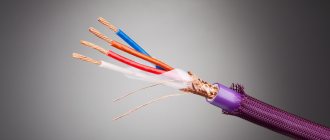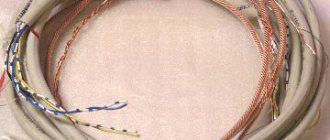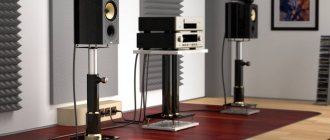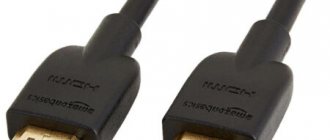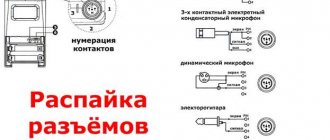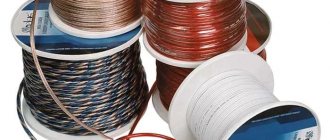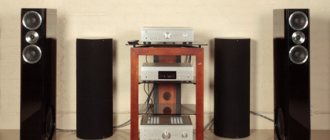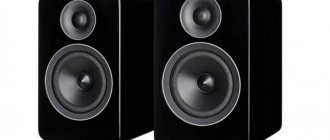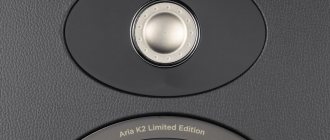If a company has produced a lot of unique audio cables over several decades, which are still produced unchanged, are in demand and receive the highest ratings, then its reputation can only be damaged by counterfeits. We will also talk about them (and even try them in the system), but actually there is a much more compelling and optimistic reason for the meeting - we will get acquainted with the cables from the new series!
All companies whose activities are closely related to high-tech production, organic chemistry, materials science and other rapidly progressing industries almost every year introduce something new to the market. I know only one “black sheep” who seems to deliberately not take advantage of this opportunity - this is Kimber Kable. The most famous American cable brand in the audio industry has not indulged in any serious innovations, if I haven’t missed anything, for a whole decade.
The company has long ago decided on suppliers of raw materials of the required quality and the entire production and technological chain, which is confirmed by the constant quality of everything that Kimber produces.
There is a simple explanation for this. The main thing Ray Kimber has already done a long time ago - it was he who, having suffered with interference from stroboscopic lighting technology that spoiled the sound of concert and disco equipment, finally came up with and then promoted specially braided cables to the market, which, like “twisted pairs”, are not sensitive to external interference and even in a conventional audio system they sound much better than traditional ones on a screen. His company has also gone through the stage of numerous experiments with different designs, conductors and insulators - the best combinations and combinations have already been found, tested and implemented in cables of a wide variety of series and price categories. Finally, the company has long ago decided on suppliers of raw materials of the required quality and the entire production and technological chain, which is confirmed by the constant quality of everything that Kimber produces. All that remains is to follow your principles and know-how: use pure materials without any impurities, achieve an ideal surface for copper conductors, use VariStrand geometry (cores with different cross-sections in a certain proportion), adhere to the most advanced methods of applying insulation and weaving patterns for finished cables ... Probably, any company would dream of being in such a high-tech “stagnation” in order to focus on issues of reducing the cost of products and promoting them in the market.
Now you understand why the release of a new series is almost an event! For its fortieth anniversary, Kimber Kable decided to give all audiophiles a gift, and a serious one at that - the newest Carbon line in the model hierarchy took place immediately below the flagship Select, moving Summit cables from their previous position (but not replacing).
After replacing the interblock Selects with Carbons, the system noticeably changed the sound. A certain articulatory playfulness and lively expressiveness appeared in the voices.
So far, the “carbon” series offers three versions of speaker cable and two types of interconnects. Technically, the new models are close to the representatives of the beloved Ascent series, which is better known for its TC speaker “braids” and Hero interconnects. The newcomers also have a minimalist design, using exclusively copper in combination with VariStrand geometry. But if in the available series a special fluoroplastic without dyes is used for insulation (and low-temperature - when it is applied, the conductor material does not have time to oxidize), then for Carbon a special carbon-containing polymer was invented, which serves as a separator between the conductor and the external Teflon insulation. The manufacturer claims that it increases conductivity by 5%, and at the same time improves the properties of the main dielectric, effectively removing static charges from it.
We will test all the Carbon models available to us (at the time of testing we only had the older XL18) against the background of the Select line, or more precisely, in comparison with models from the “copper subclass” (let me remind you that in the flagship line there are also much more expensive polymetallic and pure silver versions). It was with their help that the components in the test system were first connected: between the DAC and the pre - RCA interconnect, between the pre and the end - XLR, and then the signal was transmitted through one pair to the acoustics. The power connection is direct, without regenerators and air conditioners, but the most efficient Fisch models, which themselves are excellent filters, were selected as power cables.
The middle is not at all embellished, but rather warmer. And the details stood out very clearly.
In this combination, we received reproduction with full dynamics and extremely insightful soft detail, with a clear stereo image and a surprisingly reliable background. In general, the set looked balanced specifically for serious acoustic, operatic or classical music - there may not have been an abundance of drive, but absolute timbral order reigned. And most importantly, there was not the slightest hardware gag. The sound seemed clear, like mountain air.
Kimber Kable Carbon Interconnect RCA and XLR
Price for meter models is $685 (in rubles at the exchange rate)
Furniture makers look simple-minded - they don’t even have an outer nylon shirt. The RCA version has WBT-0114 collet tips with gold-plated contacts mounted on the four-wire “binding”, which, consider them, are native to Kimber (the same group is engaged in their production). And the balanced versions are the same “binding”, but with high-quality professional connectors from American Switchcraft.
After replacing the interblock Selects with Carbons, the system noticeably changed the sound. A certain articulatory playfulness, lively expressiveness in the voices and even hints of dashing drive appeared. The music was presented brighter than in the reference system, and usually this character indicates that we have lost something in the middle register due to blurring of shades. But here it was impossible to talk about any loss of clarity and distinguishability of timbres. The sound just became a little sharper in the upper mids and more textured in the midbass. At the same time, “Carbon” highlighted some small nuances and rustles in the scene (at the same time, however, it slightly tinted them). Some of the imaginary sources from the background approached the front line, but no other errors in the construction of the scene were revealed. The localization is accurate, the images are stable and at the correct scale, there is plenty of air. The main surprise from the inclusion of “Carbon” was the dynamics in the bass band, expressed not so much by “power” moments, but by after-sounds - embossed, rich, natural. Well, the fact that the new cables were slightly inferior in tonal neutrality of the mid and high range to the more expensive (and already well-warmed up) Selects was, in general, predictable.
Kimber Cable
Home / Kimber Cable
What's so special about Kimber cables? Let's start from afar.
In the Hi-Fi era, little attention was paid to the quality of cables: any piece of wire would do, as long as there were no short circuits and chattering due to unreliable contact in the connectors. The first person to notice the impact of cables on sound and make a big business out of it was Noel Lee, who founded the Monster Cable brand in 1979. As a real businessman, he understood that it is not so important in which direction the sound changes from changing cables, what is more important is the fact that it changes, and this hypnotizes the gullible audiophile, like a fakir cobra. As does the appearance of the cables themselves, as well as their packaging. It all worked out great.
The second proponent of the cable strategy was Bill Lowe, who founded Audioquest in 1980. His approach was different: he started from the fact that, basically, most audio systems assembled from dissimilar components are quite “crooked”, and by selecting suitable cables this curvature can be somewhat corrected, since any cable to one degree or another can perform the function “ micro-equalizer". The attractive appearance of cables also worked, but the variety of cable designs (including geometry, materials, conductor cross-sections) became large enough that there were many to choose from for any given system.
Unlike these two pioneers, Ray Kimber relied on the integrity and transparency of the cable as a conductor of the music signal. And, since honesty as such does not really correspond to the emphasis on external attributes, be it the type of packaging or the cable itself, Kimber cables from the very beginning had the simplest packaging, were not particularly thick and openly showed their structure, without hiding it under thick layers of decorative sheathing with beautiful inscriptions. Even in the most expensive and “thick” Kimber cables, their appearance is completely determined by the engineering idea, except that the massive knobs or wooden overlays on some models can be considered as elements of cable “costume jewelry”.
But let's talk about Kimber Kable in more detail, starting with the current phase of development of this brand. There is hardly anyone today who has not heard about nanotechnology and the prospects that they promise. Many people are also familiar with the material graphene, a special modification of carbon that promises a revolution in microelectronics.
What about “macroelectronics,” which includes High End Audio components? For example, cables?
Recently, the well-known company Kimber Kable announced a new series of cables with carbon conductors based on nanotechnology. And a couple of years ago, Kimber released the prestigious Axios series of cables for different models of headphones with individual selection of appropriate connectors. The conductor materials for cables in this series were traditional copper and silver. A little later, Axios USB and mini-USB cables appeared.
Kimber's earlier bestsellers are still extremely popular: the prestigious Select series, PBJ and Hero interconnects, 8TC speaker cable, Illuminati digital cable and many other models, including network ones.
It’s worth mentioning separately about Illuminati: after the company of the same name became part of Kimber Kable, audiophile-grade S/PDIF and AES/EBU cables appeared. Until then, it was believed that digital cables, unlike analog cables, had no effect on sound, until the famous cable guru Chris Sommovigo, the author of the Illuminati model, proved the opposite.
Since 1979, Kimber Kable has come a long way, remaining true to the main principle - the cable should be transparent to the signal and insensitive to external interference. Ray Kimber, the founder of the company, began his activities with the dubbing of public events, which required long, several tens of meters, low-current cables. Naturally, such systems were very sensitive to interference, and background in the speakers was a problem that Ray constantly struggled with. Instead of conventional wires, he began using homemade braided cables, and gradually reached the optimal cable geometry, which provided a minimum of interference and the best conditions for signal transmission without loss. This geometry implies an intersection angle of wires in the cable close to 90º, and a special weaving method was developed to implement it. In many cases, this geometry eliminates the screen, which has a positive effect on the sound.
Then Ray Kimber began experimenting with conductor and insulation materials and patented VariStrand™ technology (each conductor combines wires of different cross-sections). The diameter of the cores is selected in a certain way, which ensures deep suppression of mechanical resonances and vibrations, both external and internal in the thickness of the cable. Kimber Kable uses specially treated polymers for insulation, including polyethylene, fluorocarbon, Teflon, polyvinyl chloride, etc., avoiding excessive use of dyes and high temperatures. For prestigious models, WBT connectors and WattGate tips are offered as an option, cryogenic processing is used.
The function of the cable is extremely simple - to transmit a signal. But implementing it at a decent level is extremely difficult. Few cable manufacturers have managed to gain a strong reputation and ensure stable demand for their products throughout the world. The reason for the success of Kimber Kable is high-quality materials, original cable geometry and a comprehensive range. Similar principles are declared by all manufacturers. And yet the end result is always different!
An innovative approach, along with loyalty to tradition, is the key to high quality cables, even not the most expensive ones, and Kimber Kable deservedly occupies a leading position among its competitors. Kimber Kable cables are appreciated not only by end users, but also by speaker manufacturers: some of them use Kimber Kable for internal wiring of their speakers.
Categories with Kimber Cable products:
- Speaker cables
- Interconnect cables
- Phono cables
- Digital cables
- HDMI cables
- Name
- Name
- Price
- Price
- Rating
- Rating
- Reset
Sort by:
Kimber Kable Carbon Speaker 8-wire
3 meters, Single – $1875 (in rubles at the exchange rate)
The junior column "Carbon" carries the simplest tips - standard "Kimber" SBAN bananas. Before connecting this cable instead of the Select speaker cable, we also returned the interconnect standards to the path.
And they probably did it in vain. The combination of the new cable with the chain of Select 1016 RCA and 1116 XLR interconnects turned out to be not very harmonious. The sound developed caustic or rough tones across the entire spectrum, and the control of the bass seemed to be weakened - the lower register lost its solidity and was replenished with fuzzy, booming moments.
But everything fell into place when the DAC, pre and tip were again connected by Carbon. The sound has become intelligible and, perhaps, even more spatially accurate than with references! The bass is a little restrained, but with fundamental notes. The middle is not at all embellished, but rather warmer. And the details stood out very clearly. I think this is one of the most useful features of the new series. In our reference setup, there was no need to fight for even greater detail, but in a system with acoustics on conventional speakers, this increase may come in handy. Moreover, with Carbon cables, the system is stunning not in the number of parts, but in the fact that they turn out to be literally material. Sometimes you even shudder at the plausibility of the entire background picture - something somewhere creaks in the reproduced scene, but it seems that the sound did not come from the recording, but was born right in the listening room.
Kimber Kable Carbon Speaker 16-wire
2.5 meters, Single – $4030 (in rubles at the exchange rate)
From the name you might think it's just a dual version of 8-wire. Formally, this is true in terms of the cross-section of the conductors, but a 16-core cable initially has a different weaving structure and, therefore, electromagnetic interactions between the conductors work differently. Also on this sample are installed much more advanced two-layer blades WBT-0681 (screw fastening, pure copper with gold plating). I would also like to draw your attention to the fact that for acoustic “carbons” the binding of polar taps is done in a cunning way, and not by simple twisting - the “halves” of the 16th model, for example, look like a Carbon Speaker 8-wire in itself. That's why even the shorter version of the Carbon Speaker 16-wire is more than twice as expensive as the V8.
Is it worth overpaying so much for a younger model? If you want to achieve even greater density in the bass in your audio system, but in such a way that the result pleases with its composure, and not the banal amount of “fat”, “meaty” or “punchy” components, and at the same time - to express gaming articulation, to add dynamics in general and the specifics are in the middle, then there is nothing to think about - Carbon Speaker 16-wire is preferable. It makes you feel as if the speakers and even the room have literally grown in size. The scene turns out to be especially convincing: the images are full-blooded, the instruments are in the body, the voices are outlined and slightly brought forward. By the way, this cable handles the upper register even more carefully - there are no “rough” tones that slightly accentuate the creaky, noise and airy components in the recording. So, in terms of detail and purity of the upper register, the entire system connected by “Carbon” reaches almost the reference level.
The scene turns out to be especially convincing: the images are full-blooded, the instruments are in the body, the voices are outlined and slightly brought forward.
But here’s the problem: this cable did not work well with the Select interconnects, although it did not show the overt “acidity” of sound that the Carbon Speaker 8-wire paired with the latter puzzled. The conclusion is simple: acoustic “Carbon” should be combined only with “Carbon” interblock. Then the new series is revealed 100%.
KIMBER KABLE PBJ-0.5Manalog interconnect cable (pair)
KIMBER KABLE PBJ-0.5M
Kimber Kable PBJ is an iconic model of “braided” interconnect cable from the American brand Kimber Kable with three stranded conductors made of “hyper-pure” copper and placed in Teflon insulation. Patented VariStrand™ conductor technology uses strands of varying diameters to provide nearly complete suppression of mechanical resonance and vibration. In terms of sound, Kimber Kable PBJ is distinguished by the correct tonal balance, excellent articulation and information content, builds a three-dimensional sound picture in which the sound acquires stereophonic width, height and depth. The cable is equipped with proprietary RCA Kimber Kable Ultraplate connectors with anti-corrosion surface coating. Supplied in original blister packaging.
Specifications:
- Braided structure of three wires
- Conductor Technology: VariStrand™
- Conductor material: Hyper Pure Copper
- Insulation material: extruded Teflon FEP
- Connectors: proprietary RCA Kimber Cable Ultraplate
- Resistance: 53 Ohm/km
- Capacitance: 55 pF/m
- Inductance: 0.77 µH/m
- External size: 6.0 mm
- Length: 0.5 meters
Kimber Cable Technologies
- VariStrand™ is a patented stranded conductor structure with strands of varying diameters. The diameters of the cores are selected in a certain way, which ensures deep suppression of mechanical resonances and vibrations, both external and internal in the thickness of the cable
- Kimber Kable uses specially processed polymers, including polyethylene, fluorocarbon, Teflon, PVC, etc., avoiding excessive use of dyes and high temperatures
- X38R™ is a proprietary compound that offers mechanical strength, flexibility and low dielectric absorption
- Ultraplate™ – advanced technology for anti-corrosion coating of metal surfaces
- GyroQuadratic™, OGQ/2™ – weaving with orthogonal mutual orientation of conductors
- PE – polyethylene
- FPC – fluorocarbon (fluorinated polyethylene-polypropylene)
- FEP – fluoropropyleneethylene
- PTFE – polytetrafluoroethylene (Teflon)
- PVC – PVC (polyvinyl chloride)
- Black Pearl™ – specially treated pure silver
- Soldering in a nitrogen environment – no oxidation
Electrical parameters
- Сp – parasitic capacitance, pF @ 20 kHz
- Ls – parasitic inductance, µH @ 20 kHz
- Rdc – ohmic resistance, Ohm
Found in categories:
- Cables and connectors for Acoustics, Hi-Fi and High-End equipment
